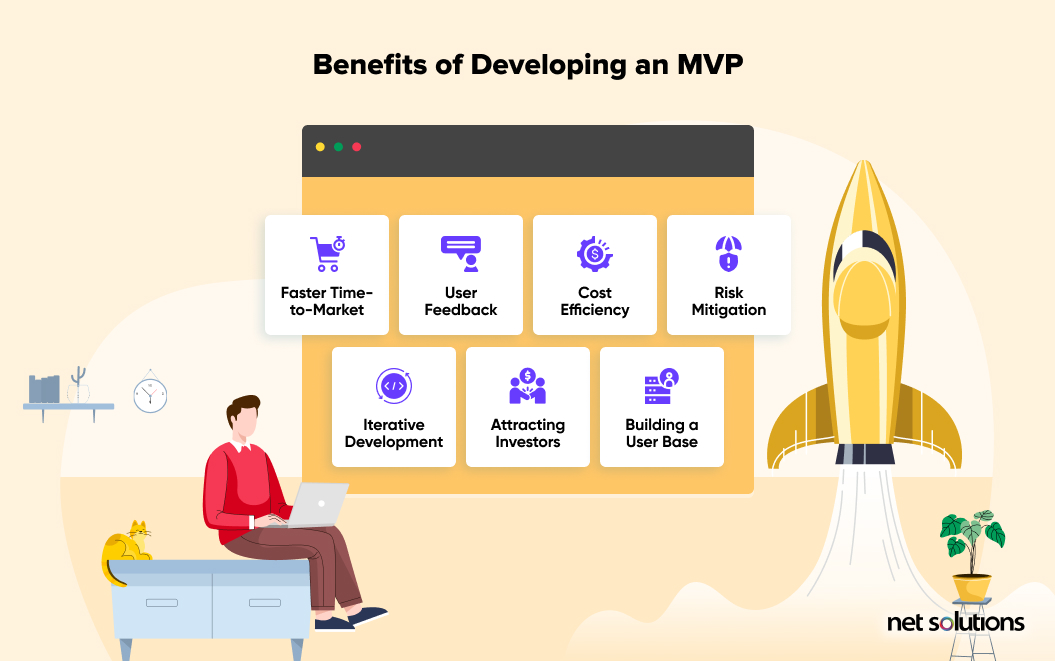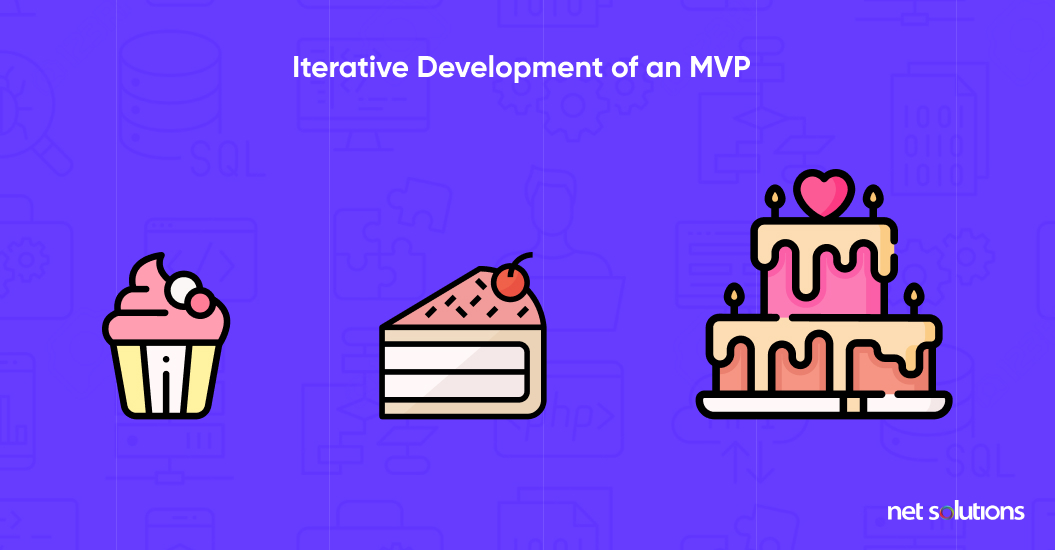Are you considering taking a Minimum Viable Product (MVP) approach for your new product launch?
An MVP is an initial version of a product that contains enough features to demonstrate and fulfill your value proposition without going overboard on a complex user interface or a wide range of features that real users may or may not value.

For example, when Uber launched their MVP, the founders tested their product concept by creating a simple platform connecting drivers with riders in the San Francisco Bay Area.
An MVP represents the least effort and lowest costs required to build a viable product, giving companies a chance to gather feedback from users that guides them when adding features for future releases.
Here are seven key, interconnected benefits that come with the MVP model. Consider each of these benefits when evaluating your development and go-to-market strategy.
1. Faster Time-to-Market
The first benefit the MVP approach offers is that it allows companies to bring their software to market much quicker than a full-fledged, feature-packed version. This can be especially beneficial to startups, who are often working on short timelines and tight budgets.
At Net Solutions, we worked with a London-based food service startup called Scoff, which focused on hyper-local restaurant delivery. The founders’ goal was to launch and scale as quickly as possible, so we suggested an MVP development approach.
You can read about Scoff’s MVP journey in our case study library, but the chief takeaway for anyone interested in building a Minimum Viable Product is that you can launch a powerful MVP with unique functionality—such as Scoff’s double-sided marketplace. The double-sided marketplace offered the same functionality to both buyers and sellers, allowing anyone to sell meals on the app.
That’s a complex feature, but it’s all a matter of prioritization. If your product’s major unique selling point requires complex coding, then you’ll move those features to the top of the list. All this underscores the value of working with a provider who understands your vision and will work with you to prioritize the essential features.
2. User Feedback
The ability to gather customer feedback is one of the most important benefits offered by an MVP approach to product development. Rather than wasting your budget building features that nobody wants, an MVP gives early adopters a chance to weigh in and tell you what they want from your software product.
This is great for validating your business idea without spending too much money upfront. If the entire idea is a bust and there’s no market for your core features, you can either pivot or cut your losses and scrap the project.
On the other hand, if your target audience demonstrates interest and proves the viability of your software development project in its early stages, then they’ll become the perfect source of ideas and new features for upcoming versions.
3. Iterative Development
We would all love to believe we’ve got the perfect product idea from the start, but the reality is that the market often has even better ideas than any entrepreneur or development team can dream up on their own.
After all, who best to asses user needs and product-market fit than your users themselves? Their input will help inform your development process, allowing you to improve usability and the User Experience (UX) so you can add features to the initial product over time.
At Net Solutions, we created an MVP for an EdTech company called EdPlace. You can read about EdTech’s journey here, but the bottom line is that our MVP approach to app building allowed them to implement changes that improved the entire platform over time gradually.
Eventually, EdPlace became an award-winning app, but Rome wasn’t built in a day. It was the iterative, Agile MVP approach that took the Minimum Viable Product from basic functionality to a final product that made waves in the industry.
Visit one of our other posts to see more successful examples of MVPs.
4. Cost Efficiency
Building a full-fledged software product with all its bells and whistles from the beginning is not only time-consuming, but it’s expensive! What’s more? It’s wasteful, considering that the market might not even want the features we imagine them wanting.
One of the top benefits of building an MVP is that it reduces development costs in the long run. When Diogo Sarillo came to us for help building his business soft-skills training app called Avance, he had received numerous quotes that went way beyond his budget.
We recommended he build an MVP to keep costs reasonable and allow him to reap all the other rewards of this business model. Diogo’s idea proved to be a successful one, and he was able to launch at a reasonable price—adding features to later versions that were informed by market demand.
You can read the full Avance case study in our case study library.
5. Risk Mitigation
App development always involves evaluating and mitigating risks—mistakes that could impact the success of your project. An MVP model can help reduce risks associated with building complex features that the market ultimately rejects, leading to wasted effort and expenses.
In his seminal book The Lean Startup, Eric Ries explores how the Lean methodology can be applied to software creation. Lean was traditionally used in manufacturing, and it works well in software when you make a few tweaks to the strategy. The MVP approach, he argues, offers the highest potential for ROI with the lowest risk factors.
Creating a stripped-down model and allowing your user base to guide future development for each subsequent version of a new product reduces to risk of draining resources and paves the way for success.
6. Attracting Investors and Stakeholders
Attracting investors for a software product is no easy feat, especially when a product is particularly visionary—as was the case with Airbnb in the beginning.
The founders of Airbnb were rejected by seven potential investors in 2007, and many derided the idea. In fact, one investor was offered a 10% stake in the company for a $150,000 investment, but he walked away from the meeting and left founder Brian Chesky alone in a cafe.
One way to calm investors’ minds is to have an MVP in place that offers some degree of market validation and the potential for monetization. Of course, that’s no guarantee—Airbnb had a solid MVP in place early on, but the idea was so radical that the founders needed some truly visionary venture capitalists to take a chance on it.
Nevertheless, an MVP that solves a specific problem, has attracted a foundational user base, and has a roadmap in place for regularly adding new sets of features based on customer feedback is far more likely to attract investors, all things being equal.
7. Building a User Base
An MVP approach helps companies begin building a user base even before their official product launch. Startups and established companies achieve this by actively soliciting feedback from beta testers and building a community among early adopters.
Why does this help build a user base? Simply put, people love getting in on the ground floor for products they truly value. In fact, this isn’t just true for brand new products—it works for new features like Spotify’s AI DJ, which they beta-tested among their existing users long before launch.
Notice that these seven benefits are intertwined, from cost-savings and iteration to attracting investors and building a user base. All this makes the MVP approach a powerful tool in your arsenal, whether you’re a bootstrapping startup or an established tech giant.
Start Building Your MVP
Do you have a product idea you’d like to bring to life, starting with an MVP?
Net Solutions has been designing and building custom software products for more than 20 years, and we can spearhead your entire efforts or offer targeted support at every stage, from design to development to MVP testing.
We’ve built award-winning software for everyone from startups to multi-national organizations, such as American Golf, Euro Car Parts, and the Harvard Business Review.
Talk to one of our experts today to see what we can do for you.
SHARE THIS POST
Table of Contents
Related Resources
- What Is an MVP App? A Guide to Building Successful Products
- A Step-by-Step Guide to Build a Minimum Viable Product (MVP)
- 19-Step Minimum Viable Product (MVP) Checklist [With PDF]
- How Much Does a Minimum Viable Product (MVP) Cost? Here’s the Answer
- 10 Top MVP Development Companies [Great for Startups]
- 10 Minimum Viable Product (MVP) Examples You Should Know
- The Ultimate Guide to Developing an MVP in Agile: What, How, and Why
- A Step-by-Step Guide on how to Master Your MVP Launch in 2025
- How to Prioritize Features for Your Minimum Viable Product (MVP)
- How to Test an MVP: 15 Proven Strategies that Work
- 20 Great MVP Tools to Help You Create & Launch Your Product
- 11 different Types of MVPs to Kickstart Your Software Project
- How to Nail MVP Design with UX Design Principles that Work
- MVP Website: Benefits, Best Practices, How to Build & More


